When Michael Parlante was a child, the celebrated painter Edwin Dickinson lived across the street from him near Cove Road in Wellfleet. “I’d watch him painting in his front yard,” says Parlante. He also remembers Dickinson’s studio stacked with paintings. At the time, Parlante’s interest in art didn’t extend beyond his habit of eating peaches from the tree in the famous artist’s yard.
But for the past 30 years, Parlante has been collecting paintings of Wellfleet. Twenty works from his impressive collection, including paintings by notable Cape artists John Whorf and Henry Hensche, are on view at the Wellfleet Public Library through the end of the month.
Collecting is a longstanding passion for Parlante, who works as a fisherman harvesting oysters in Wellfleet. He started buying art at auctions after collecting a range of other objects, including comic books, postcards, and historical deeds and documents. (He is also an expert at finding Native American tools and arrowheads in the local landscape and donated two display cases of these items to the Wellfleet Historical Society in 2021.)
“I started noticing Wellfleet paintings coming up now and then at auctions,” says Parlante. “No one wanted paintings of Wellfleet at that time. They wanted Provincetown paintings.” Parlante saw that as an opportunity: he started bidding on the paintings and soon got hooked.
One of his early acquisitions is a gutsy watercolor by Deborah Delp Weisel, painted in the first half of the 20th century, that typifies American modernist painting with its use of flat shapes and simplified forms. Weisel’s picture combines nature with industry and architecture in a scene of a railroad running across Duck Creek.
“It reminds me of a John Marin watercolor,” says Wellfleet artist Julia Salinger, who was in the library looking at the show after printing copies of a play she had just finished writing. “It’s so abstract and graphic, and the boldness of the color is the kind of thing you see at that spot.”
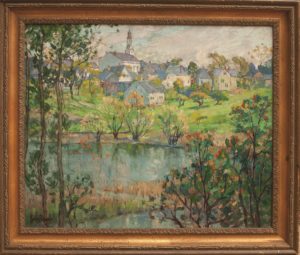
Parlante says that many paintings of Wellfleet are hiding in plain sight: “People don’t know they’re views of Wellfleet.”
Weisel’s painting is a case in point. The railroad is long gone, as are the shacks in the middle ground and a group of cottages in the background. “Those are the Lemon Pie Cottages that were once owned by Lorenzo Dow Baker,” says Parlante. “I’ve collected thousands of postcards of different views of the town. So, when I see a painting, I can recognize it as depicting a scene in Wellfleet.”
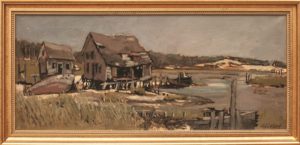
At one auction, Parlante recognized a John Whorf painting as a Wellfleet scene but lost it to a collector from the North Shore. (“He had more money than God,” says Parlante.) However, when the collector realized it wasn’t a painting of the Boston area, he put it back up for auction. Parlante claims that the picture is Whorf’s only known painting of Wellfleet. Now hanging at the library, it depicts a pair of crumbling oyster shacks on Duck Creek in a palette of subdued grays.
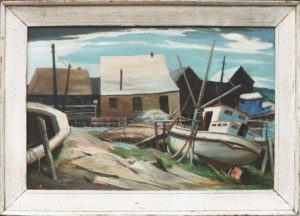
The environs of Duck Creek — with its railroad trestle, oyster shacks, tidal flows, and marshlands — show up in about half the paintings in the exhibition, many of which were painted in the middle of the 20th century. It seems that Wellfleet was a convenient day trip for artists who could take the train from Provincetown and visit a place that was rich with possibilities. Paintings by Marston Hodgin and Glada B. Walker in Parlante’s collection best convey the area’s compositional complexity. Boats lie at divergent angles to one another, and the crowded jumble of oyster shacks rises above the water. In Walker’s painting, the water opens to the distance, like a breath of air.
“The paintings show a working village with lots of oystering going on,” says Parlante. The oyster shacks were used to process and store the shellfish before being loaded onto trains at the nearby depot for delivery to urban centers.
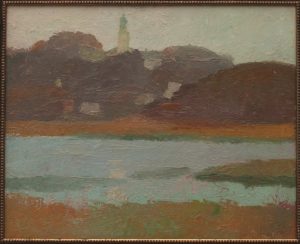
Henry Hensche painted in this same area but turned away from industrial activity, focusing instead on a scene of the marsh with the town rising on a hillside above. Unlike the high-contrast, summery paintings for which he is known, the small painting in Parlante’s collection, seemingly done with a palette knife, is a study in cool, atmospheric color. It’s pleasant to think that perhaps he and John Whorf took the train together from Provincetown to paint in Wellfleet on a cloudy summer day.
Jack Hall’s stark wintertime depiction of Cape Cod Bay from Bound Brook Island represents a view of Wellfleet untouched by human intervention. It was given to Parlante by Peter Watts, the Wellfleet landscape painter, who died in 2020. Drifts of snow spread out menacingly on a dark dune. Beyond, an unforgiving gray sea stretches to the horizon. While there’s something cerebral about its abstracted, interlocking shapes, it’s a painting that still makes you shiver.
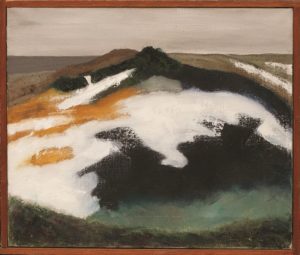
Wellfleet’s town center figures as a central character in other paintings, most notably in Nancy Whorf’s picture of Commercial Street in the 1970s. The painting was originally part of a table from which Parlante removed the legs. It’s wildly different from the artist’s better-known snowy scenes of Provincetown streets: the former tabletop is populated by Wellfleet characters that Parlante remembers (including Gypsy, a horse tied up by the liquor store).
The paintings also conjure memories for Salinger. “It reminds me of the stillness and sense of adventure of summer in Wellfleet,” she says of a Martha Ryther painting of a fish shop and fire station below the Masonic Lodge. There’s a sense of mystery in the picture: on one edge, stairs lead upward to an unknown destination; in the center of the painting, a man, his back to the viewer, climbs into the back of a car.
Parlante is often at the library searching online for art. But he also has a few people on the lookout for Wellfleet paintings, including artist Arthur Egeli and fellow collector Todd Perry. He acquired one of the oldest works in the exhibition — an impressionist painting by Pauline Palmer — when Egeli spotted it online and brought it to his attention. Palmer’s painting shows the back of the town viewed from Mill Hill Road, with Squire’s Pond in the foreground and the town rising in the distance. Like the area around Duck Creek, the view was commonly painted by artists including Charles Heinz and Xavier Gonzalez, who made a calligraphic ink drawing of the scene that is distinctive for its elegant economy of mark.
Viewed together, Parlante’s collection reveals a multidimensional perspective of Wellfleet: one that varies through time, weather, and the eyes of the many artists who approached it as their muse.
The Wellfleet Collection
The event: An exhibition of paintings of Wellfleet from the collection of Michael Parlante.
The time: Opening reception with Parlante and David Wright of the Wellfleet Historical Society on Friday, Jan. 20, 3 to 5 p.m. The exhibition is on view until Jan. 27.
The place: Wellfleet Public Library, 55 West Main St.
The cost: Free
